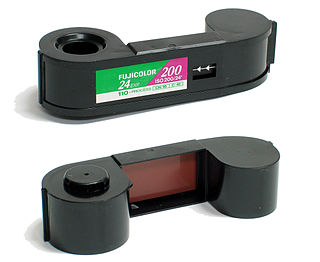
110 is a cartridge-based film format used in still photography. It was introduced by Kodak in 1972. 110 is essentially a miniaturized version of Kodak's earlier 126 film format. Each frame is 13 mm × 17 mm, with one registration hole. Cartridges with 12, 20, or 24 frames are available on-line. Production variations sometimes have allowed for an additional image.

The Holga is a medium format 120 film camera, made in Hong Kong, known for its low-fidelity aesthetic.

Minolta Co., Ltd. was a Japanese manufacturer of cameras, camera accessories, photocopiers, fax machines, and laser printers. Minolta Co., Ltd., which is also known simply as Minolta, was founded in Osaka, Japan, in 1928 as Nichi-Doku Shashinki Shōten. It made the first integrated autofocus 35 mm SLR camera system. In 1931, the company adopted its final name, an acronym for "Mechanism, Instruments, Optics, and Lenses by Tashima".

The Minolta MAXXUM 7000 35 mm SLR camera was introduced in February 1985. It was the first camera to feature both integrated autofocus (AF) and motorised film advance, the standard configuration for later amateur and professional single lens reflex cameras.

TC-1 is a luxury point and shoot camera that was produced by Minolta. It is a compact 35 mm clad in titanium, equipped with a G-Rokkor 28mm f/3.5 lens. The TC-1 was equipped with a high quality lens and body, similar to other luxury compacts produced during the Japanese bubble economy era, including the Contax T line, Konica Hexar, Leica minilux, Nikon 28/35Ti, Ricoh GR series, and Rollei QZ 35W/35T. Expensive when initially released in 1996 with a suggested retail price of ¥148,000, it was produced in small numbers and since then has become collectible.

The Canon A-1 is an advanced-level single-lens reflex (SLR) 35 mm film camera for use with interchangeable lenses. It was manufactured by Canon Camera K. K. in Japan from March 1978 to 1985. It employs a horizontal cloth-curtain focal-plane shutter with a speed range of 30 to 1/1000 second plus bulb and flash synchronization speed of 1/60 second. It has dimensions of 92 millimetres (3.6 in) height, 141 millimetres (5.6 in) width, 48 millimetres (1.9 in) depth and 620 grams (22 oz) weight. Unlike most SLRs of the time, it was available in only one color; all black. The introductory US list price for the body plus Canon FD 50 mm f/1.4 SSC lens was $625; the camera body was generally sold with a 30–40% discount.

The Canon AL-1 was an FD mount, 35mm single-lens reflex camera introduced in March 1982. Its main feature was the "Quick Focus" focus-assist system that was aimed at those who had trouble focusing through the viewfinder—either novices, or those with poor eyesight—and was intended to head off competition from the first full-autofocus cameras from other manufacturers, such as the Pentax ME F.

The Minolta Vectis S-series comprises two APS system models of film SLR cameras made by Minolta, the flagship model Vectis S-1 and the Vectis S-100. The cameras feature a compact design, owing to the use of mirrors instead of prisms in the viewfinder.

The LOMO LC-A is a fixed lens, 35 mm film, leaf shutter, zone focus, and compact camera introduced in 1984. Its design is based on the Cosina CX-2, with the difference being that it lacks a swiveling front and self-timer. It was built in Soviet-era Leningrad by Leningrad Optics and Mechanics Association (LOMO).

The Minolta XG-M was a 35mm single-lens reflex camera introduced in 1981 by Minolta of Japan. It was also known as the X-70 on the Japanese market, in which it was not available until 1982. When released, it was the top model in Minolta's XG series of consumer-grade manual focus SLRs, replacing the XG-9. Changes from that model included a metered manual mode, and a revised body style with rearranged controls. This was also the first camera to use Minolta's new logo, which was used until the 2003 merger into Konica Minolta.
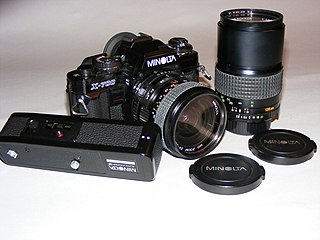
The Minolta X-700 is a 35 mm single-lens reflex film camera introduced by Minolta in 1981. It was the top model of their final manual-focus SLR series before the introduction of the auto-focus Minolta Maxxum 7000.
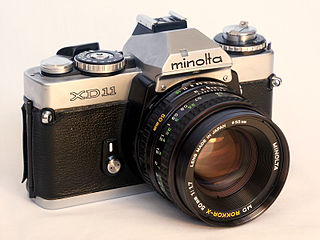
The Minolta XD-7 is a 35mm SLR film camera manufactured by Minolta from 1977 until 1984.

The Minolta A-mount camera system was a line of photographic equipment from Minolta introduced in 1985 with the world's first integrated autofocus system in the camera body with interchangeable lenses. The system used a lens mount called A-mount, with a flange focal distance 44.50 mm, one millimeter longer, 43.5 mm, than the previous SR mount from 1958. The new mount was wider, 49.7 mm vs. 44.97 mm, than the older SR-mount and due to the longer flange focal distance, old manual lenses were incompatible with the new system. Minolta bought the autofocus technology of Leica Correfot camera which was partly used on the a-mount autofocus technology. The mount is now used by Sony, who bought the SLR camera division from Konica Minolta, Konica and Minolta having merged a few years before.

The Leica M mount is a camera lens mount introduced in 1954 with the Leica M3, and a range of lenses. It has been used on all the Leica M-series cameras and certain accessories up to the current film Leica M-A and digital Leica M11 cameras.

The Minolta CLE is a TTL-metering manual & automatic exposure aperture-priority 35 mm rangefinder camera using Leica M lenses, introduced by Minolta in 1980.

The Minolta 9000 AF is a professional Single-lens reflex autofocus camera, introduced by Minolta in August 1985. It was both Minolta's and the world's first professional autofocus SLR. It was called Minolta Maxxum 9000 in the US and Minolta α-9000 in Japan.

The Minolta 9xi was, when released in 1992, an advanced 35 mm single-lens reflex camera design. According to the company, it incorporated the world's "fastest autofocus system", had a maximum shutter speed of 1/12000 of a second, and had a 14-zone metering system. It has a shooting speed of 4.5 frames per second without the additional motor pack, a shutter speed of 1/12000 of a second due to carbon-reinforced shutter blades, a pentaprism, and it is compatible with xi zoom lenses having a "power zoom function".
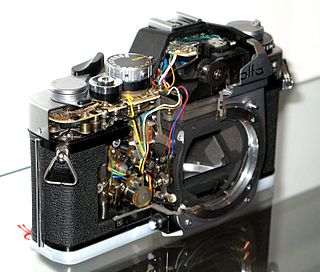
The Minolta SR-mount was the bayonet mounting system used in all 35 mm SLR cameras made by Minolta with interchangeable manual focusing lenses. Several iterations of the mounting were produced over the decades, and as a result, the mount itself was sometimes referred to by the name of the corresponding lens generation instead.
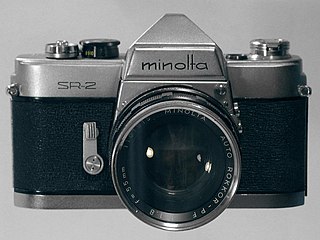
The Minolta SR-2 was presented in 1958 as the first 35mm SLR camera from Chiyoda Kogaku. Popular cameras of this type at that time were mainly from Europe but a few from Japan, including the Asahi Pentax, the Miranda T and the Topcon R. The miniature SLR camera concept was conceived in the 1930s at Ihagee in Dresden, resulting in the 1936 Kine Exakta. Influential cameras designs like that of the 1939 KW Praktiflex, the 1949 ZI Contax S, and 1952 the KW Praktina marked the steady progress toward a perfected SLR. Several features of the latter seem to have influenced the design of the SR-2 although dissimilar in many respects. The obvious similarities are the stepped top plate, the carrying strap lugs, the self-timer lever and some general body features.



















